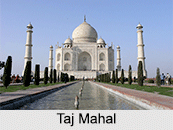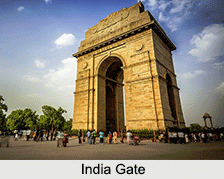 Indian Historical Monuments display a blend of various styles. Different rulers conquered India and reigned for a long period of time. At the end of their rule, India was gifted with a rich inheritance of archaeological tradition. Among all periods, Mughal period is called the `Golden Period of Architecture` and produced the majority of Indian Historical Monuments.
Indian Historical Monuments display a blend of various styles. Different rulers conquered India and reigned for a long period of time. At the end of their rule, India was gifted with a rich inheritance of archaeological tradition. Among all periods, Mughal period is called the `Golden Period of Architecture` and produced the majority of Indian Historical Monuments.
Mughals brought with them Persian architectural style and justified the influence through the Indian historical monuments of their era. The Mughal kings were patrons behind the formation of grand monuments and buildings in different parts of India. Legends and parables are attached with all the fascinating Indian historical monuments including palaces, forts, victory pillars, synagogues and tombs.
Famous Indian Historical Monuments
From Kashmir to Kanyakumari there are many Indian historical monuments reflecting the charm of the golden era. Hazratbal Mosque, Jama Masjid, Shankaracharya Temple, Khanqah of Shah Hamadan and Makhdoom Sahib are some of the popular monuments of Jammu and Kashmir. Following are the Famous Indian Historical Monuments:
Taj Mahal: Taj Mahal, the top of Mughal architecture, was built by the Mughal ruler Shah Jahan who was a grandson of Akbar the immense, in the memory of his queen Arjumand Bano Begum, enabled "Mumtaz Mahal". The Taj Mahal is the grave of both Mumtaz and Shah Jahan.
 Hawa Mahal: Hawa Mahal stands straight as the doorway to the City of Jaipur. An imperative landmark in the city, Hawa Mahal is an embodiment of the Rajputana architecture. The pyramid shape of this early monument is a tourist attraction having 953 small windows.
Hawa Mahal: Hawa Mahal stands straight as the doorway to the City of Jaipur. An imperative landmark in the city, Hawa Mahal is an embodiment of the Rajputana architecture. The pyramid shape of this early monument is a tourist attraction having 953 small windows.
Mysore Palace: The Mysore Palace of Karnataka is commonly known as the "Maharaja"s Palace", situated at the city centre at Mirza Road. Mysore Palace is one of the most captivating monument of Mysore city. The other name of the Mysore Palace is "Amba Vilas" and is the major palaces of India.
Victoria Memorial: Victoria Memorial is one of India"s most stunning monuments, represents an exclusive blend of classical European architecture and Mughal motifs.
Charminar: The charminar of Hyderabad is best recognized landmark which was built 1591 by Sultan Mohammed Quli Qutub Shah to settle the force of evil savaging his new city with outbreak and epidemic. Standing in the heart of the old walled city and surround by energetic bazaars, the charminar is a 56m high triumphal doorway.
Qutub Minar: Qutub-ud-din Aibak laid the establishment for Qutub Minar in 1199 AD and his descendant and son-in-law Shamsu"d-Din- Iitutmish completed the construction by adding up three more stories. Standing at 72.5 meters, it is the highest stone tower in India.
Sanchi Stupa: Sanchi Stupa is located in the state of Madhya Pradesh in India. It lies at a distance of about 52 km from the capital city of Bhopal and 10 km from Vidisha. The major attractions of Sanchi comprise a number of Buddhist stupas, monasteries, temples and pillars.
Gateway of India: The royal Gateway of India is a magnificent historical memorial built in British rule. This wonderful monument has been built in Indo-Sarcenic style to remember the visit of King George V and Queen Mary to Bombay (Mumbai). Gateway of India is one of the finest examples of royally architectural heritage in India.
Cellular Jail: The Cellular Jail was a majestic prison situated in the Andaman and Nicobar Islands, India. The prison was used by the British particularly to separate political prisoners. Many distinguished freedom fighters such as Batukeshwar Dutt and Veer Savarkar, among others, were imprisoned here during the fight for India"s independence.
Jaisalmer Fort: Jaisalmer Fort is one of the biggest forts in the world. Located in the city of Jaisalmer in Rajasthan, this fort is a World Heritage Site and is also one of the biggest tourist attractions. Built in 1156 AD by Rawal Jaisal who was Rajput ruler, this fort is also recognized as the "Sonar Quila" or the "Golden Fort".
Khajuraho Group of Monuments: The Khajuraho Group of Monuments is a grouping of beautiful Hindu and Jain temples situated all in Madhya Pradesh. Also a part of the UNESCO World Heritage Site, they are one of the most well-liked monuments of India. 
Golden Temple: The Golden Temple is the holiest Sikh gurdwara which is situated in the city of Amritsar also referred to as the Golden Temple of India.
India Gate: The India Gate is a war monument which is also acknowledged as All India War Memorial and the pride of.
Konark Sun Temple: Konark Sun Temple is in the shape of an extremely large chariot. The monument was also called the Black Pagoda by European sailors.
Red Fort: The Red Fort is situated in the middle of Delhi and houses a number of museums, named for its extremely large enclosing walls of red sandstone.
Hampi Monuments: Hampi is the second principal city in the world with numerous other monuments. The Group of Monuments at Hampi located on the southern bank of the river Tungabhadra is one of the most empires of medieval India called the Vijayanagar Empire.
Meenakshi Amman Temple: Meenakshi Amman Temple is a major figure for the Tamil people and is mainly important landmark and most visited tourist attraction in the city. The Meenakshi temple is one of the largest temple complexes in Tamil Nadu.
Jama Masjid: Jama Masjid of Delhi is the major mosque in India. The mosque has three huge gates constructed of strips of red sandstone and white marble and one of the most famous Landmarks of Delhi.
Chhatrapati Shivaji Terminus: Chhatrapati Shivaji Terminus is an historic railway station in Mumbai and World Heritage Site.



















